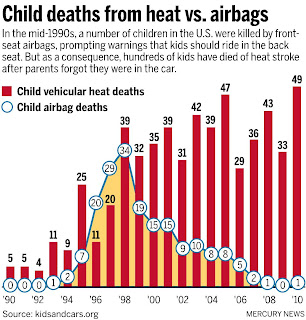Our family spent the past weekend at the Santa Cruz Beach Boardwalk, and I came home with a stomach full of fried food and a sunburn on the nose. Luckily, I was more cautious applying sunscreen to the kids, so they managed to escape with nothing more than a deep tan (which I know is still bad for them).
But what is the evidence to support sunscreen as a means of preventing skin cancer? The medical world has known for some time that sunscreen protects against squamous-cell cancer. But for melanoma, the deadliest form of skin cancer, the studies have been mostly inconclusive. Most studies were observational, meaning the researchers just asked participants whether they used sunscreen, and then looked to see whether they developed melanoma. The problem was that people who were the most prone to getting skin cancer – namely, the fair-haired, freckled folk with a positive family history – were the most likely to use sunscreen, thus confounding the results.
After a prolonged wait, we now have data from a clinical trial showing that sunscreen use does indeed reduce the risk of melanoma – at least if you use it on a daily basis. The Nambour Skin Cancer Prevention Trial randomized over 1600 adults in Queensland, Australia to either daily sunscreen use or “discretionary” use, meaning the patients could choose when they wanted to apply their sunscreen. Australia has the highest skin cancer rates in the world, so it was an ideal population to study. Those in the daily group were given free supplies of broad-spectrum (UVA and UVB protection) SPF 16+ sunscreen and told to apply it to the head, neck, arms and hands every morning and after heavy sweating or bathing. Many went a step further and applied it to their trunk and legs – why not, if they were getting it for free? The trial lasted four and a half years, and by the end, the researchers could not find a statistically significant difference in the rates of skin cancer between the two groups.
Fortunately, the investigators didn’t throw in the towel, knowing that the carcinogenic effects of UV radiation can take years. They continued to follow the two study groups, long after they stopped giving out free sunscreen. Turns out that a good portion of the daily sunscreen group couldn’t kick the habit, even after the negative results were published. Eight years after the trial started, the daily sunscreen group was found to have a lower rate of squamous cell cancer. Fourteen years after the start of the trial, the researchers published further findings in the January 2011 issue of the Journal of Clinical Oncology: The rates of invasive melanoma had dropped 73% in the daily sunscreen group. Finally, here was empirical evidence that sunscreen reduces the risk of melanoma. The catch? The absolute risk reduction was quite small, dropping from 1.35% to 0.37%, over the 14-year period. Now, a 1% absolute risk reduction is actually pretty darn good when it comes to cancer prevention. The real issue is the cost. The Journal of the American Medical Association recommends about 21 teaspoons be applied to the average adult for optimal coverage. Even if one of my children uses, conservatively speaking, only 10 teaspoons a day, an 8 oz. tube of Banana Boat Kids would last fewer than 5 days. At about $7.00 per 8 oz., that’s $539 per kid per year, for a minimum of 4 years, and that’s doesn’t include re-applications after water exposure!
Now you could argue that even though the Australian study enrolled only adults, the benefits of sunscreen would probably be even greater in children, which is a good point. You could also argue that any amount of money is worth the price of your child not developing a lethal cancer, which is a bad point. I mean, sure, if I knew my child had a 100% chance of developing melanoma without sunscreen, I’d mortgage the house and give up the Peets -- whatever it took to protect her. But it’s not 100%. It’s not even the1.35% over a 14-year period seen in the Queensland study. In the U.S., the annual incidence of melanoma is 0.027% in whites and 0.0017% in Asians. So if someone (Healthnet, are you listening?) would be willing to supply the daily sunscreen for free, what the heck, I’d do it. But that’s not likely to happen, and I’d rather make sure my daughter gets the HPV vaccine when the time comes to make a real dent in her risk of cancer. But that's a topic for another blog entry...




